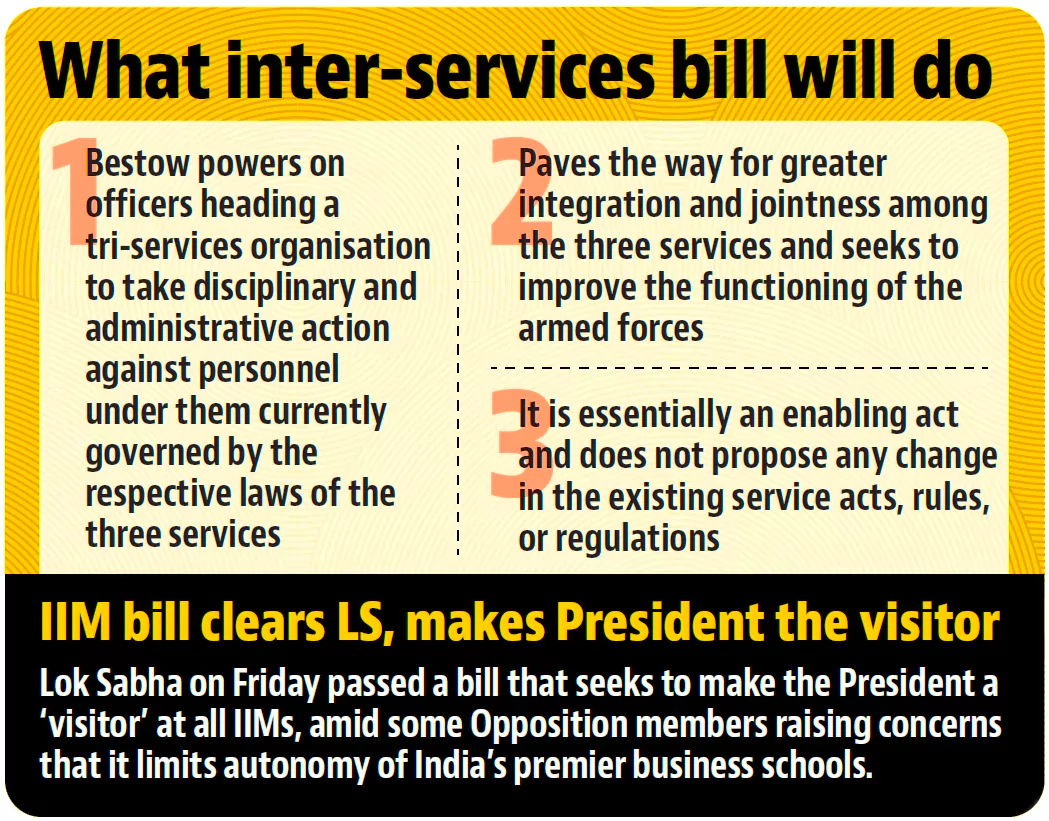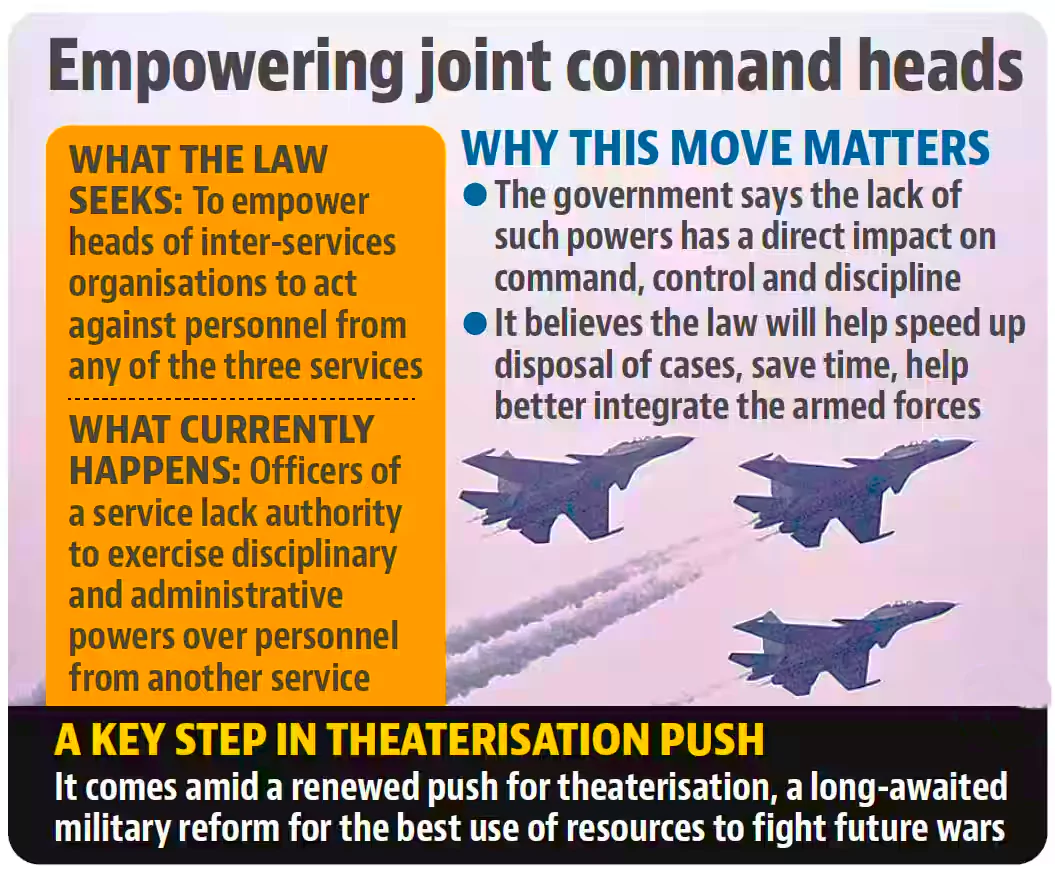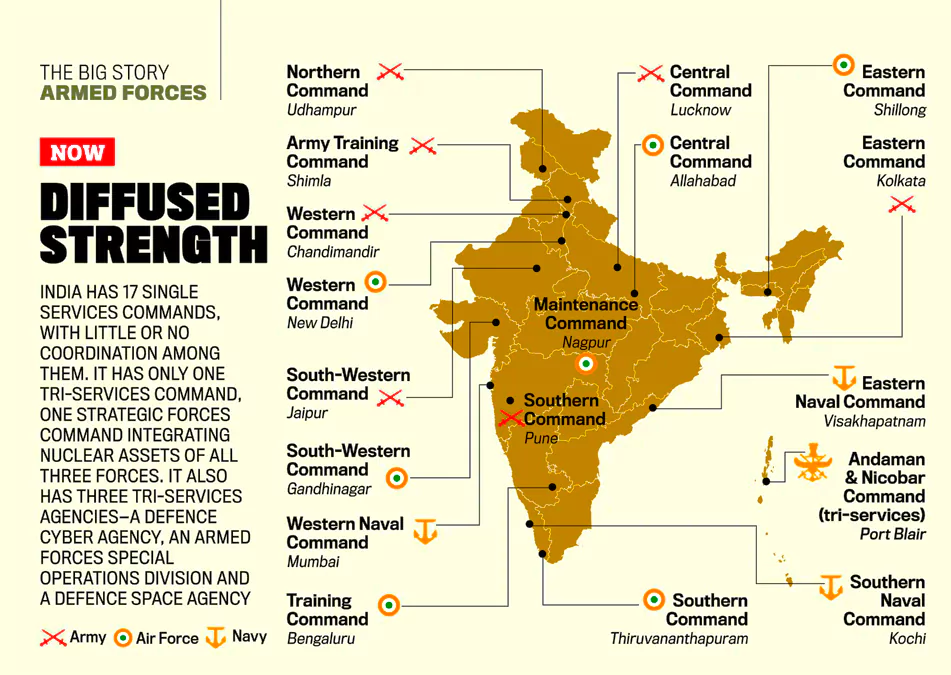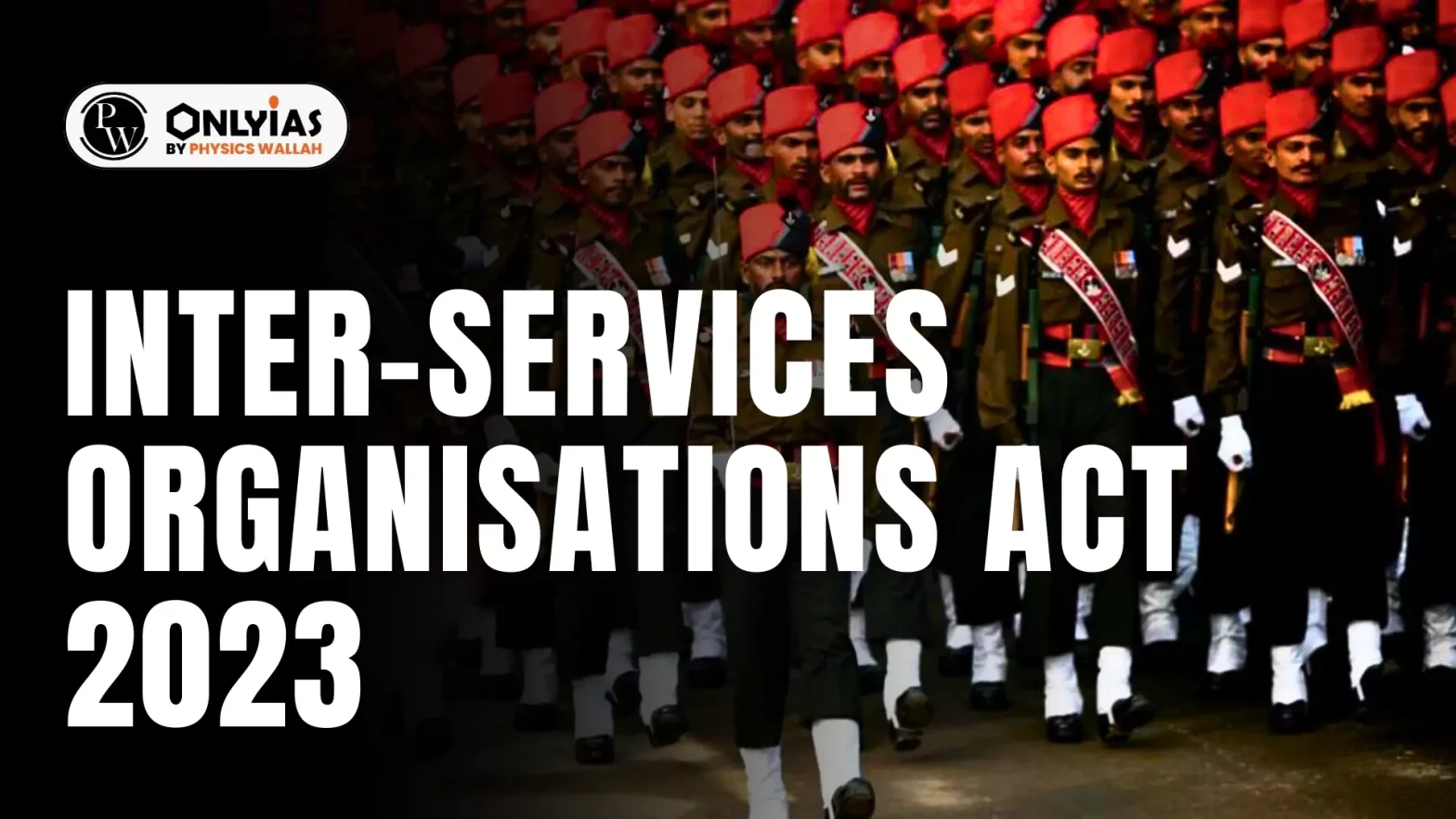Context
Recently, the Indian Government has notified the Inter-Services Organisations (ISOs) (Command, Control, and Discipline) Act, 2023 through a Gazette notification.
Inter-Services Organizations Bill 2023

- The Inter-Services Organisations (ISOs) (Command, Control, and Discipline) bill was passed by both the Houses of Parliament during the Monsoon Session of 2023 and received the assent of the President on August 15, 2023 and through a Gazette notification, enforced with effect from May 10, 2024.
- This development coincides with the government’s broader theaterisation plan to enhance coordination and efficiency across the Army, Air Force, and Navy.
- In high level military reforms, the post of Chief of Defence Staff (CDS) was created in 2019 with the mandate to ensure “jointness” of the three services in operations, logistics, transport, training, support services, communications, repairs, and maintenance.
- The top priority for the CDS is the proposed reorganization of the armed forces into integrated theater commands.
Enroll now for UPSC Online Course
Gazette Notifications:
- Gazette of India Notifications are published by the Department of Publication and are printed by the Government of India Printing Presses regularly.
- This is an authorized legal document of the Government of India containing the mode of operations under the law of the land.
Theaterisation Model:
- Under this model, the government seeks to integrate the capabilities of the Army, the Air Force and the Navy, and optimally utilize their resources for wars and operations.
|
About Theatre Commands
A theatre command in the military refers to a specific geographical area where military operations are planned, coordinated, and executed under a single command.
- Aim: To enhance coordination and synergy among the Army, Navy and Air Forces.
- Practiced in: Currently, almost all major countries like China, Russia, the US, the UK and France work on this concept.
- In the US and China these theatre commands are based on the region of operation, but India is taking a different approach. India’s theatre commands adhere to the concept of ‘One Border One Force,’ which ensures focused and efficient management.
- In India, the Shekatkar Committee (in 2015) had recommended the creation of 3 integrated theatre commands — northern for the China border, western for the Pakistan border, and southern for the maritime role.
Theatre Commands of China:
- China reorganized its People’s Liberation Army into five theatre commands in 2016.
- Aim: To enhance offensive capabilities and improve command-and-control structures.
|
Need for Theatre Commands in India

- For Theaterisation: It will result in the best utilization of the military’s resources to fight future wars.
- To Counter Challenges of Present Framework:
- Specific Service Legislations: At present, personnel of the Army, the Navy and the Air Force are governed in accordance with the provisions contained in their specific service Acts- the Army Act, 1950; the Navy Act, 1957; and the Air Force Act, 1950.
- At the time of enactment of these respective Acts, most of the service organisations largely comprised personnel from a single service either Army, Navy or the Air Force. However, now there are numerous inter-services organisations where personnel of the armed forces and other forces serve together.
- Separate Disciplinary Powers: The commander-in-chief or the officer-in-command of inter-services organisations is not empowered to exercise disciplinary or administrative powers over personnel belonging to other services. The lack of such powers had a direct impact on command, control and discipline.
- Only officers of the respective services are empowered to exercise disciplinary powers over the service personnel under their respective Service Acts.
- To Lowering Financial Cost: The existing framework is time-consuming and involves financial costs to move the personnel.
- Currently, the Army and the IAF have seven commands each while the Navy has three.
- Also, there are two tri-service commands – the Andaman and Nicobar Command and the Strategic Forces Command (SFC) – apart from the Headquarters Integrated Defence Staff (HQ IDS).
- There are also some tri-service organisations like the Defence Intelligence Agency, Defence Cyber Agency, Defence Space Agency, etc.
Enroll now for UPSC Online Classes
Inter-Services Organisations Act 2023

The Inter-Services Organisations Act 2023 comes ahead of the planned re-organisation of the Indian military into integrated theatre commands. It is essentially an ‘enabling Act’ and does not propose any change in the existing Service Acts/Rules/Regulations which are time-tested and have withstood judicial scrutiny over the last six decades or more.
- Aim: To bolster effective command, control, and efficient functioning of the ISOs.
- It is part of a series of steps being taken by the government to strengthen the armed forces. It also empowers the central government to constitute an inter-services organisation.
- Features of the Inter-Services Organisations Act 2023:
| A Joint Service Command: |
- Existing Inter-services Organisations will be deemed to have been constituted under the Inter-Services Organisations Act 2023.
- These include the Andaman and Nicobar Command, the Defence Space Agency, and the National Defence Academy.
- Personnel of ISO will belong to at least two of the three services: the army, the navy, and the air force.
- ISO will also include a Joint Services Command, which may be placed under the command of a Commander-in-Chief.
|
| Controlling Power: |
- It empowers the Commander-in-Chief or the Officer-in-Command of an ISO to exercise command and control over the personnel serving in or attached to it.
- He/she would be responsible for maintaining discipline and ensuring proper discharge of duties by the service personnel.
|
| Role of Government: |
- Superintendence of an ISO will be vested in the Central Government.
- The government will issue directions to such organisations on grounds of national security, general administration, or public interest.
- The Central Government may notify any force raised and maintained in India to which the Act is applicable.
- This would be in addition to army, navy, and air force personnel.
|
| Eligibility for Commander-in-Chie: |
- A General Officer of the regular Army (above the rank of Brigadier), or
- A Flag Officer of the Navy (rank of Admiral of the Fleet, Admiral, Vice-Admiral, or Rear-Admiral), or
- An Air Officer of the Air Force (above the rank of group captain)
|
| Function of Commander-in-Chie: |
- He will be empowered to exercise all disciplinary and administrative powers vested in:
(i) General Officer Commanding the Army,
(ii) Flag Officer Commanding-in-Chief of a Naval Command,
(iii) Air Officer Commanding-in-Chief of an Air Command,
(iv) any other officer/authority specified in the service Acts,
(v) any other officer/authority notified by the government. |
| Commanding Officer (CO): |
- CO will be in command of a unit, ship, or establishment.
- The officer will also perform duties assigned by the Commander-in-Chief or Officer-in-Command of the Inter-services Organisation.
- CO will be empowered to initiate all disciplinary or administrative actions over the personnel appointed, posted, or attached to that ISO.
|
| Theatre Commands: |
- The northern theatre command is likely to be in Lucknow.
- The maritime theatre command is likely to have its base in Coimbatore and will involve the IAF’s Prayagraj-headquartered Central Command.
- Earlier, the plans were to set up the maritime theatre command headquarters in Karwar.
- Its Southern Air Command is based in Thiruvananthapuram.
- The existing Andaman and Nicobar Command may be subsumed into the maritime theatre command and the HQ IDS will operate under the CDS.
- The SFC will continue to operate independently.
- Strategy: The overall plan is to establish three adversary-based theatre commands – one facing Pakistan, another opposite China, and a maritime theatre command to tackle maritime threats outside the coastal borders of the country.
|
Significance of the Inter-Services Organisations Act 2023
- Effective Maintenance: The Inter-Services Organisations Act 2023 empowers Commanders-in-Chief and Officers-in-Command of ISOs to exercise control over Service personnel, serving under them, for effective maintenance of discipline and administration, without disturbing the unique service conditions of each individual Service.
 Effective Resource Utilization: The forces will be able to pool their resources efficiently, resulting in the optimum utilisation of platforms, weapon systems, and assets.
Effective Resource Utilization: The forces will be able to pool their resources efficiently, resulting in the optimum utilisation of platforms, weapon systems, and assets. - Greater Integration among Armed Forces Personnel: The Act will empower the Heads of ISOs and pave the way for expeditious disposal of cases, avoid multiple proceedings and will be a step towards greater integration & jointness among the Armed Forces personnel.
- It lays a strong foundation for creation of joint structures in times to come and further improve the functioning of the armed forces.
- This move is crucial as India faces evolving security challenges, requiring a more cohesive and integrated military structure.
- Streamlining & Enhancement of Processes & Operations: It will streamline command and control structures, enhancing synergy in planning, logistics, and operations.
- India currently operates 17 single-service commands (Army 7, IAF 7, and Navy 3), which often operate independently, leading to inefficiencies. The ISO Act seeks to address these challenges by providing a unified framework for military operations.
- To Safeguard National Interests: Theatre commands, in the long run, could also improve logistics management in the forces. A framework to collectively cater to the requirements of the three services could prove more beneficial than individual plans. It is significant to safeguard national interests in today’s complex security landscape.
- Also, having a unified command structure with representatives from all three services will also lead to more efficient planning for both peacetime and wartime strategies.
- Simpler & Efficient Communication: With a unified command structure, the communication processes could be simpler and more efficient as multiple levels of clearances across hierarchies and geographies are needed to corroborate plans and strategies.
- Currently, India’s multiple military commands are all located in different geographical areas. This, at times, causes communication hindrances during joint operations and exercises.
Challenges to the Theatre Commands
- Educational Bedrock: In terms of preparing the educational bedrock for military personnel to serve in theatre commands, India seems to be lagging behind.
- National Security Strategy (NSS): Many retired military professionals have criticised implementing theatre commands without having a coherent National Security Strategy (NSS). Essentially arguing that the theatre commands will not have a clear blueprint and policy objective to work towards without an NSS.
- Inter-Service Competition: The intense focus of each service on its own assets and influence can hinder the creation of synergy among the services.
- Perception of Army Dominance: Concerns are arising over the integration of the commands that may perpetuate the perceived dominance of the army and provide it with greater operational control.
- Limited Experience: With limited experience of integrated theatre commands, its implementation and adjustments in India is a serious challenge.
- Infrastructure and Logistics: Coordinating and synchronizing the infrastructure and logistics requirements across different services could be complex and resource-intensive.
Enroll now for UPSC Online Course
Way Forward
- Institutional & Ideational Changes: As India moves towards implementing its biggest military overhaul, which could undoubtedly be a force multiplier, a few institutional and ideational changes will have to be incorporated to find the correct balance in such a transformation.
- Reworking on Curriculum: Also, the curriculum at staff colleges and war colleges can be reworked to provide officers with the knowledge and transferable skills to serve at the headquarters of corresponding services.
Also Read: India Defence Exports: A Strategic Imperative
![]() 12 May 2024
12 May 2024




 Effective Resource Utilization: The forces will be able to pool their resources efficiently, resulting in the optimum utilisation of platforms, weapon systems, and assets.
Effective Resource Utilization: The forces will be able to pool their resources efficiently, resulting in the optimum utilisation of platforms, weapon systems, and assets. 